Taking a Closer Look: How Strawberry Disease Risk Varies With Microclimates at the Canopy Level
Recorded May 4, 2022
Download presentation slides (PDF, 4.1 MB)
Description

Strawberry with gray mold. Photo by Gerald Holmes, Strawberry Center, Cal Poly San Luis Obispo, Bugwood.org.
Weather stations in strawberry fields might seem like good sources of highly local environmental data, but this assumes sun, wind, and shade affect an area evenly. There can be microclimate variations at the canopy level, especially when row covers are used for plasticulture strawberry production.
Row covers serve an important purpose, since they can ward off freeze and frost damage during winter and early spring, and they may be needed to enhance plant growth during late fall. But they introduce a need to be more granular when taking weather measurements.
We found that canopy-level weather sensors produced different data when compared to nearby weather stations, and by conducting efficacy trials, we found that these differences play a role in designing effective fungicide treatments.

Mengjun Hu, assistant professor of plant pathology in the Department of Plant Science and Landscape Architecture at the University of Maryland.
Mengjun Hu
Mengjun Hu is an assistant professor of plant pathology in the Department of Plant Science and Landscape Architecture at the University of Maryland (UMD). He works closely with growers, stakeholders, and other specialists to establish research and extension programs relevant to grape and small fruits in the Mid-Atlantic region. Prior to joining UMD, he was a postdoctoral fellow at Clemson University, where he studied fungicide resistance and was involved in a multi-year fungicide-resistance monitoring program for strawberry gray mold.
